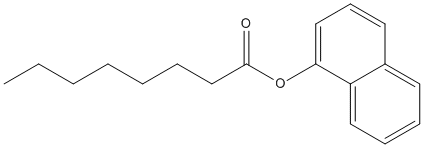1-Naphtylcaprylate
General
Type : Octanoate || Naphtyl ester || Naphthalen || Aromatic ester (two rings)
Chemical_Nomenclature : naphthalen-1-yl octanoate
Canonical SMILES : CCCCCCCC(=O)OC1=CC=CC2=CC=CC=C21
InChI : InChI=1S\/C18H22O2\/c1-2-3-4-5-6-14-18(19)20-17-13-9-11-15-10-7-8-12-16(15)17\/h7-13H,2-6,14H2,1H3
InChIKey : SUAOWWVNMRJABO-UHFFFAOYSA-N
Other name(s) : Octanoic acid, 1-naphthyl ester, 1-Naphthyl octanoate, naphthyl caprylate, naphthyl octanoate, SCHEMBL451182, Caprylic acid 1-naphthyl ester, Octanoic acid, naphthalenyl ester, ZINC2568067, alpha-NC, C8-naphthyl ester

Target
Families : Tannase, LYsophospholipase_carboxylesterase
References (2)
| Title : Characterization of a novel lipolytic enzyme from Aspergillus oryzae - Koseki_2013_Appl.Microbiol.Biotechnol_97_5351 |
| Author(s) : Koseki T , Asai S , Saito N , Mori M , Sakaguchi Y , Ikeda K , Shiono Y |
| Ref : Applied Microbiology & Biotechnology , 97 :5351 , 2013 |
| Abstract : Koseki_2013_Appl.Microbiol.Biotechnol_97_5351 |
| ESTHER : Koseki_2013_Appl.Microbiol.Biotechnol_97_5351 |
| PubMedSearch : Koseki_2013_Appl.Microbiol.Biotechnol_97_5351 |
| PubMedID: 23001008 |
| Gene_locus related to this paper: aspor-q2uf27 |
| Title : Isolation, characterization, and heterologous expression of a carboxylesterase of Pseudomonas aeruginosa PAO1 - Pesaresi_2005_Curr.Microbiol_50_102 |
| Author(s) : Pesaresi A , Devescovi G , Lamba D , Venturi V , Degrassi G |
| Ref : Curr Microbiol , 50 :102 , 2005 |
| Abstract : Pesaresi_2005_Curr.Microbiol_50_102 |
| ESTHER : Pesaresi_2005_Curr.Microbiol_50_102 |
| PubMedSearch : Pesaresi_2005_Curr.Microbiol_50_102 |
| PubMedID: 15717224 |
| Gene_locus related to this paper: pseae-PA3859 |